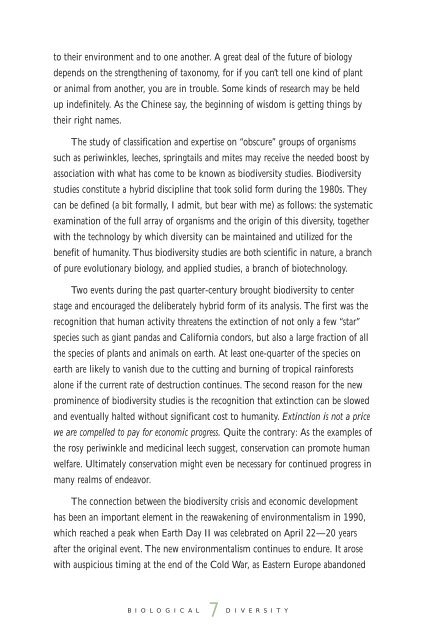Download Biological Diversity - New York State Museum
Download Biological Diversity - New York State Museum
Download Biological Diversity - New York State Museum
Create successful ePaper yourself
Turn your PDF publications into a flip-book with our unique Google optimized e-Paper software.
to their environment and to one another. A great deal of the future of biology<br />
depends on the strengthening of taxonomy, for if you can’t tell one kind of plant<br />
or animal from another, you are in trouble. Some kinds of research may be held<br />
up indefinitely. As the Chinese say, the beginning of wisdom is getting things by<br />
their right names.<br />
The study of classification and expertise on “obscure” groups of organisms<br />
such as periwinkles, leeches, springtails and mites may receive the needed boost by<br />
association with what has come to be known as biodiversity studies. Biodiversity<br />
studies constitute a hybrid discipline that took solid form during the 1980s. They<br />
can be defined (a bit formally, I admit, but bear with me) as follows: the systematic<br />
examination of the full array of organisms and the origin of this diversity, together<br />
with the technology by which diversity can be maintained and utilized for the<br />
benefit of humanity. Thus biodiversity studies are both scientific in nature, a branch<br />
of pure evolutionary biology, and applied studies, a branch of biotechnology.<br />
Two events during the past quarter-century brought biodiversity to center<br />
stage and encouraged the deliberately hybrid form of its analysis. The first was the<br />
recognition that human activity threatens the extinction of not only a few “star”<br />
species such as giant pandas and California condors, but also a large fraction of all<br />
the species of plants and animals on earth. At least one-quarter of the species on<br />
earth are likely to vanish due to the cutting and burning of tropical rainforests<br />
alone if the current rate of destruction continues. The second reason for the new<br />
prominence of biodiversity studies is the recognition that extinction can be slowed<br />
and eventually halted without significant cost to humanity. Extinction is not a price<br />
we are compelled to pay for economic progress. Quite the contrary: As the examples of<br />
the rosy periwinkle and medicinal leech suggest, conservation can promote human<br />
welfare. Ultimately conservation might even be necessary for continued progress in<br />
many realms of endeavor.<br />
The connection between the biodiversity crisis and economic development<br />
has been an important element in the reawakening of environmentalism in 1990,<br />
which reached a peak when Earth Day II was celebrated on April 22—20 years<br />
after the original event. The new environmentalism continues to endure. It arose<br />
with auspicious timing at the end of the Cold War, as Eastern Europe abandoned<br />
B i o l o g i c a l<br />
7 D i v e r s i t y
















